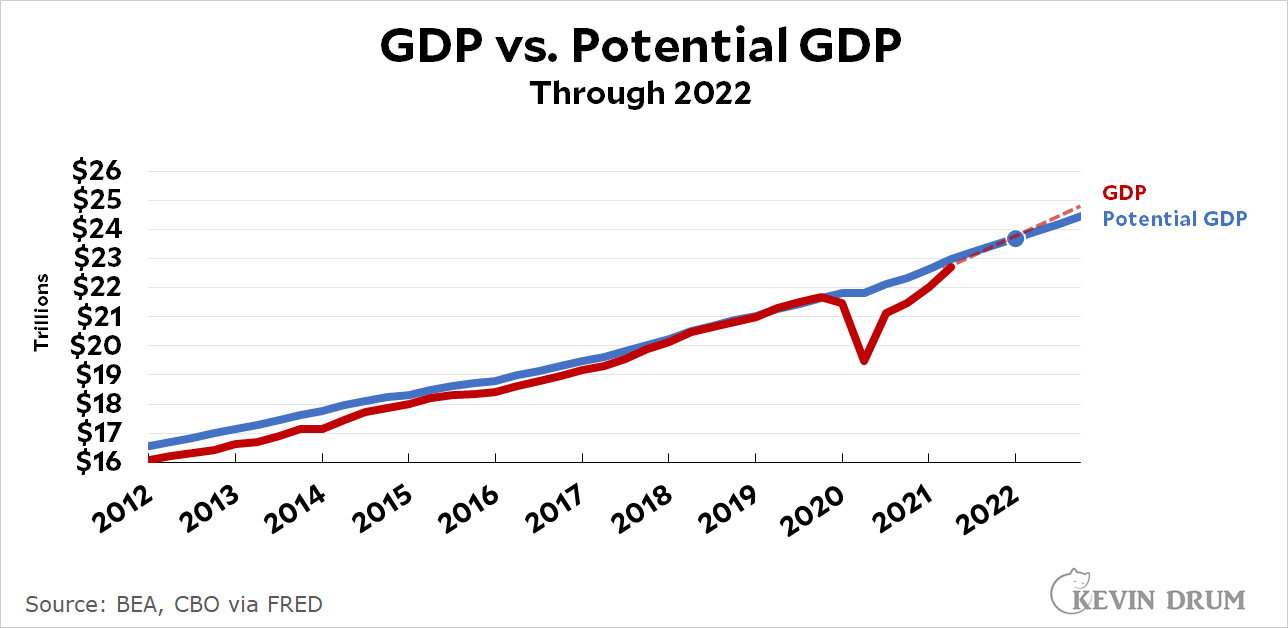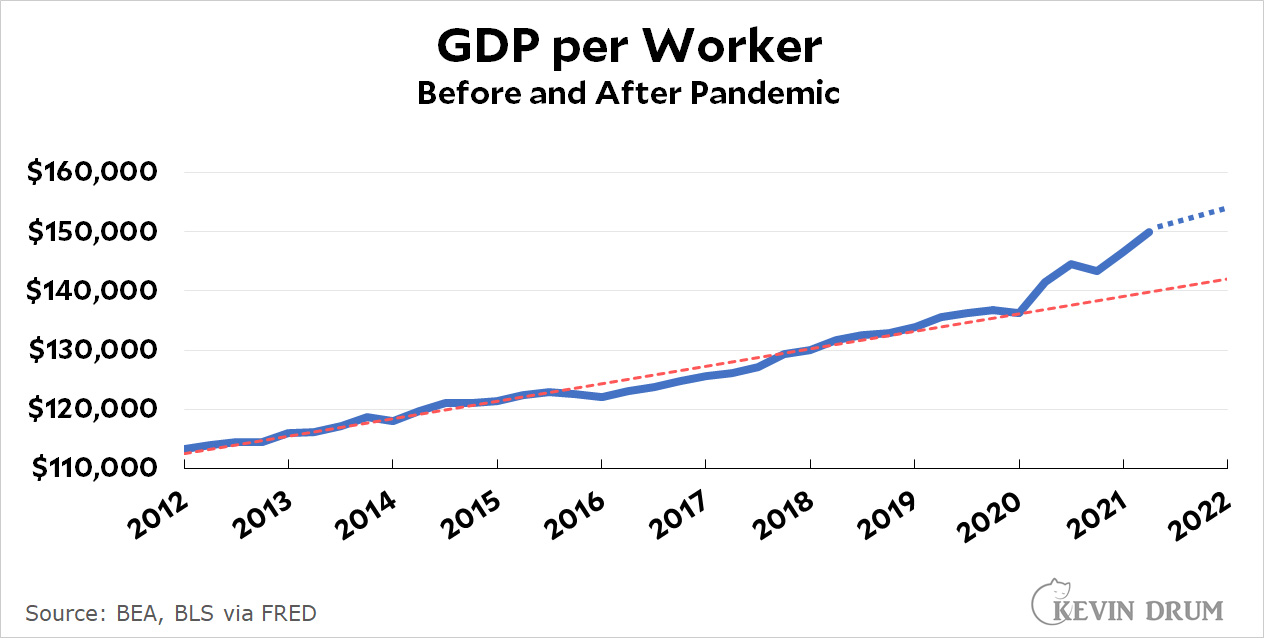How will our torrid economic expansion end up? The following is just one possible scenario based on projections from other people along with some educated guesswork. First, here is the CBO's projection of potential GDP:

Even if our current growth rate slows down a bit, as it surely will, we'll make up all the loss of GDP we suffered during the pandemic by the first quarter of 2022, with GDP running at about $23.7 trillion. Now here's worker productivity:

Productivity jumped during the pandemic and shows no sign of returning to its pre-pandemic level. Even if productivity growth slows down a bit, it will hit about $153,000 per worker by the first quarter of 2022.
At this rate, by 2022 we will have a labor force of about 155 million workers compared to:
- Current employment of 151.5 million
- Pre-pandemic peak of 158 million
- Trendline level of 163 million.
In other words, it's quite plausible that by the beginning of 2022 the economy will be running at full capacity with a workforce that's only 3.5 million higher than it is today. This compares to an 8-million worker "gap" that you hear about frequently, which is based on employment following the pre-pandemic trendline.
As I said, this is just one scenario, though it's a plausible one. I think it's quite likely that we'll never make up that 8-million worker gap. By the start of 2022 we'll have a roaring economy at an employment level only 3.5 million higher than it is now.
It's been common for jobless recoveries like this to follow recent recessions. Employers learn they can do more with less, or they adopt technology at higher levels and then keep it when the recession ends. In any case, the real employment gap right now is probably around 3-4 million workers. Or so I'm guessing.

Assuming Kevin is correct then:
Politically, does Biden ever get credit for a robust and full economic recovery?
What happens to the 4 million formally employed people? Disability? Under the table employment?
The "worker gap" is not having enough workers needed to reach full potential GDP. You can try to pull in people who have dropped out of the workforce or cut back to one or two jobs, or immigration. We just had a great jobs report--lots of new employment but on a small drop in unemployment numbers--mainly because people were pulled back into the job market. The will go on a bit longer, then basically we'll hit "full employment". Our demographics are shifting, though not nearly as bad as Japan's did a while back, nor as bad as the one China will be facing soon, so our workforce is not growing as fast as our population.
Retirement surged which is being missed. My guess by the mid-2020's, is when employment recovers in aggregate. That is when a bubble is likely in U.S. debt. With problems in India and the weak UK start manifesting as Fed liquidity dry up.
Would retirements be measured in some way? Like once you start collecting SS?
My mother retired right before covid. But my stepfather also "retired" because his business basically folded.
My personal data/anecdotes from those within my circle:
1. Several recent college grads who are not entering the workforce. They are just staying at home as if its some year abroad.
2. People who needed two incomes pre-covid have realized they can eak by on a single salary since they aren't spending as much as they did (not paying for daycare is a huge "increase" in cash on hand). Once kids are back in school this could change for them.
3. Many working under the table in the trades.
In other words, it's quite plausible that by the beginning of 2022 the economy will be running at full capacity with a workforce that's only 3.5 million higher than it is today. This compares to an 8-million worker "gap" that you hear about frequently, which is based on employment following the pre-pandemic trendline.
Does this not suggest that a lot of working age people genuinely prefer to not work, ie, to retire early? Because if not, the implication is that economy won't really be "running at full capacity." If there are several million workers on the sidelines who want/need to work but can't find jobs, my inference is the economy is below capacity.
Don't forget that the 'Baby Boom' was followed by a 'Baby Bust' so that there simply are not as many workers in the population after the boomers retire.
Immigration should be bumping up our numbers enough to prevent an absolute decline in the working age population, at least for now. I believe the country has received something like 30 million non-elderly immigrants since the first baby boomers turned 18.
If not, then we're in worse shape than I'd imagined (we'd basically be in China/Japan/Italy territory, all three of which are seeing shrinking workforces).
What has happened that would boost real productivity as applied to living standard? Has the economy really shifted gears with massive new investment? Have robots been taking over all the jobs? (no, they haven't despite Kevin's predictions)
Productivity is a tricky statistic. The hiring cycle tends to lag the production cycle. It is dangerous to make projections from short-term trends. This is something that media economics writers usually don't get - they are focused on the latest numbers and how they have changed since last month.
What happened is that poorly paid, low productivity workers, many in the hospitality trades were laid off. It's just like the phantom wage increase.
Pingback: The Future of the Economy Depends on How Many Workers Come Back | PRO Gambler
Pingback: The unemployed may never come back. Here’s what that means for the economy. – The Nzuchi Business Insider
Pingback: The Foreseeable future of the Financial state Relies upon on How Many Personnel Come Back - Wilkinson Knaggs
Pingback: बेरोजगार कभी वापस नहीं आ सकते। यहाँ अर्थव्यवस्था के लिए इसका क्या अर्थ है। – IndiaHulchul
Pingback: قد لا يعود العاطلون عن العمل أبدا. هذا ما يعنيه ذلك بالنسبة للاقتصاد. - Arabbitcoin
Pingback: The Future of the Financial state Is dependent on How Many Staff Come Back - Wilkenson Knaggs
Pingback: The unemployed may never come back. Here's what that means for the economy. - iNFO Vi
Pingback: বেকাররা হয়তো আর ফিরে আসবে না। অর্থনীতির জন্য এর অর্থ এখানে। – KolkataInfo
Pingback: The unemployed may never come back. Here’s what that means for the economy. – The Vine
Pingback: The Future of the Economy Depends on How Many Workers Come Back – ThisBiginFluence.com
Pingback: The unemployed may never come back. Here's what that means for the economy. - Minnesota Business Insights
Pingback: The unemployed may never come back. Here's what that means for the economy. - USVI News
Pingback: The unemployed may never come back. Here's what that means for the economy. – Invest Like A Champ
Pingback: The unemployed may never come back. Here's what that means for the economy. – Investor Newsletter
Pingback: The Future of the Economy Depends on How Many Workers Come Back - You Startups
Pingback: The Future of the Economy Depends on How Many Workers Come Back - India Talks
Pingback: The unemployed may never come back. Here’s what that means for the economy. | GeorgMedia
Pingback: The unemployed may never come back. Here’s what that means for the economy. – Business Insider | Yahkal News